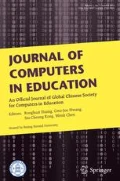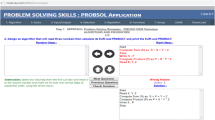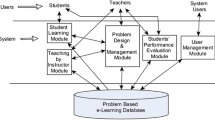Abstract
PHP is one of the most popular web programming languages. Many people want to learn PHP because of its simplicity. One of the important features of PHP is that it is a server-side scripting language. Learning PHP is more effective if a student can learn through a real environment. Many PHP online-learning systems and hardcopy books are available at present. Problem-based learning (PBL) is an effective pedagogy used to increase the problem-solving skill of the students. Existing PHP learning systems support limited problems in real-life environment. In this work, we have integrated the conventional e-learning of PHP with the PBL pedagogy to improve the problem-solving capability of the students. In this system, a teacher designs some problems for the students. Each problem contains proper description and reference with standard PHP output. On the web server, students can practice and submit answers pertaining to the problem with the help of the relevant references, urls, examples, and standard output. System provides the facility for the students to practice and experiment on coding with real-time error. Students can edit codes repeatedly comparing their outputs with the standard output within the specific duration. For evaluation, a teacher can compare the students’ submitted codes with the standard code of the system, predefined keywords, and outputs. This system helps the students to engage in self-learning of PHP based on the real problems.













Similar content being viewed by others
References
Akili, W. (2011). On implementation of problem-based learning in engineering education: Thoughts, strategies and working models. In Frontiers in Education Conference (FIE), 2011, pp. S3B–1. IEEE.
Alam, M. R. (August 2010). HTML document - DOC type tutorial in Bangla. Retrieved Nov 9, 2015 from http://www.webcoachbd.com/about-us.
Cass, S. (2014). Top 10 programming languages. Retrieved May 24, 2015 http://spectrum.ieee.org/computing/software/top-10-programming-languages.
Fontes, L. M. D. O., Neto, F. M. M., Pontes, A. A., et al. (2011). A multiagent system to support problem-based learning. Creative Education, 2(05), 452.
Garcia-Robles, R., Diaz-del Rio, F., Vicente-Diaz, S., & Linares-Barranco, A. (2009). An elearning standard approach for supporting PBL in computer engineering. Education, IEEE Transactions on, 52(3), 328–339.
Government of Ontario, Canada (2006). e-Learning Ontario. Retrieved May 24, 2015 from https://courses.elearningontario.ca/.
Hiekata, K., Yamato, H., Rojanakamolsan, P., & Oishi, W. (2007). A framework for design engineering education with workflow-based e-learning system. Journal of Software, 2(4), 88–95.
Hwang, W.-Y., Wang, C.-Y., Hwang, G.-J., Huang, Y.-M., & Huang, S. (2008). A web-based programming learning environment to support cognitive development. Interacting with Computers, 20(6), 524–534.
Blackboard Inc., B. (1997). Blackboard. Retrieved May 24, 2015 from http://www.blackboard.com/.
Index, P. (2014). Python is the language of the year. Retrieved May 24, 2015 from https://sites.google.com/site/pydatalog/pypl/python-blog/pythonisthelanguageoftheyear.
Istrate, O. (2009). Visual and pedagogical design of elearning content. E-learning Papers, (17).
Jantschi, L., Bolboaca, S. D., Marta, M. M., & Laszlo, A. (2008). E-learning and e-evaluation: A case study. In Human System Interactions, 2008 Conference on, pp. 840–845. IEEE.
Java2s Developers (2013). Programming tutorials and source code examples. Retrieved May 24, 2015 from http://java2s.com/.
Kaldoudi, E., Bamidis, P., Papaioakeim, M., & Vargemezis, V. (2008). Problem-based learning via web 2.0 technologies. In Computer-Based Medical Systems, 2008. CBMS’08. 21st IEEE International Symposium on, pp. 391–396. IEEE.
Khan, S. (2006). Khan academy. Retrieved Nov 9, from https://www.khanacademy.org/computing/computer-programming/html-css/intro-to-html/p/html-basics.
Korea and Work, B. C. (2009). Bangladesh-Korea information access center. Retrieved May 24, 2015 from http://cse.buet.ac.bd/iac/quickweb.php.
Lai, P., Tang, K. C. C., & Jianqiu, D. (1999). Constraints affecting the implementation of problem-based learning (PBL) strategy in university courses. Proceedings of the First Asia Pacific Conference on Problem Based Learning, 49–54.
Lee, M.-C. & Chung, Y.-K. (2010). Using object-orientation to conceptualize an adaptive learning content management system modeling. In Advanced Computer Control (ICACC), 2010 2nd International Conference on, Vol. 3, pp. 56–60. IEEE.
Mantri, A., Dutt, S., Gupta, J., & Chitkara, M. (2008). Designing problems for problem-based learning courses in analogue electronics: Cognitive and pedagogical issues. Australasian Journal of Engineering Education, 14(2), 33–42.
Pattnaik, S., Pattnayak, J., & Dash, P. (2010). E-learning: A milestone in the research of data mining. Special Issue of IJCCT, 2, 137–141.
Prakashe, V. A. (2009). Managing e-content: Ways and issues.
Qiu, L. & Riesbeck, C. K. (2005). Designing web-based interactive learning environments for problem-based learning. In Advanced Learning Technologies, 2005. ICALT 2005. Fifth IEEE International Conference on, pp. 333–337. IEEE.
Qiu, M. & Chen, L. (2010). A problem-based learning approach to teaching an advanced software engineering course. In Education Technology and Computer Science (ETCS), 2010 Second International Workshop on, Vol. 3, pp. 252–255. IEEE.
Refsnes Data and Consulting Company (1998). W3Schools online web tutorial. Retrieved May 24, 2015 from http://www.w3schools.com/.
Richardson, I. & Delaney, Y. (2009). Problem based learning in the software engineering classroom. In Software Engineering Education and Training, 2009. CSEET’09. 22nd Conference on, pp. 174–181. IEEE.
Shamad, M. M. (2005). New approaches in medicine: Evidence-based medicine and problem based learning. Sudan J Dermatol, 2005 (pp. 1–5). College of Medicine : University of Juba, Sudan.
Suman (2011). HTML Bangla tutorial using notepad. Retrieved Nov 9, 2015 from https://www.youtube.com/watch?v=QP2aoKLFYG4&list=PLF5F7A55C54E1655C.
Ullah, A. (2012). HTML Bangla tutorial by Atique Ullah. Retrieved Nov 9, 2015 from https://www.youtube.com/watch?v=kVbW4156A24.
Xianmei, L., Biao, L., Lingjiang, Y., Peng, C., & Juan, L. (2010). Design and implement of intelligent e-learning learner analysis system. In 2010 International Conference on Networking and Digital Society, Vol. 1, pp. 490–493.
Yang, T.-C., Hwang, G.-J., Yang, S. J., & Hwang, G.-H. (2015). A two-tier test-based approach to improving students’ computer-programming skills in a web-based learning environment. Journal of Educational Technology & Society, 18(1), 198–210.
Yueh, H.-P. & Lin, W.-J. (2005). Developing a web-based environment in supporting students team-working and learning in a problem-based learning approach. In Creating, Connecting and Collaborating through Computing, 2005. C5 2005. Third International Conference on, pp. 145–149. IEEE.
Acknowledgments
This research was performed in the Department of Computer Science and Engineering (CSE), Bangladesh University of Engineering and Technology (BUET) supported by the Information and Communication Technology Division, Ministry of Posts, Telecommunications and Information Technology, Government of the People’s Republic of Bangladesh.
Author information
Authors and Affiliations
Corresponding author
Rights and permissions
About this article
Cite this article
Bashir, G.M.M., Hoque, A.S.M.L. & Nath, B.C.D. E-learning of PHP based on the solutions of real-life problems. J. Comput. Educ. 3, 105–129 (2016). https://doi.org/10.1007/s40692-015-0050-1
Received:
Revised:
Accepted:
Published:
Issue Date:
DOI: https://doi.org/10.1007/s40692-015-0050-1




